10% SPECIAL DISCOUNT IN SELECTED CITY TOURS > CLAIM YOUR PROMO CODE AND BOOK NOW
Canyoning (“canyoneering” in USA or “barranquismo” in Spanish) is the activity of going through canyons using a variety of techniques including walking, scrambling, jumping, abseiling (rappelling), and swimming. Canyons that are ideal for canyoning are often cut into the bedrock stone, forming narrow gorges with numerous drops, beautifully sculpted walls, and sometimes spectacular waterfalls. Most canyons are cut into limestone, sandstone, granite or basalt. Canyons can be very easy or extremely difficult. A wide variety of canyoning routes are found throughout Spain, and canyoning adventures are enjoyed by people of all ages and skill levels.
Canyoning is frequently done in remote and rugged settings and often requires navigational, route-finding and other wilderness travel skills. There are water canyons and dry canyons.
2. GETTING READY: COLLECT INFORMATION AND PREPARATION.
The first thing you have to do before canyoning, is to collect information about it: how is the canyon, how many rappels it has, how many jumps, how high they are, etc. You can check published Canyoning Guide Books of a particular area or specialized websites. With these data, you can better prepare your individual equipment and collective gear you have to bring for the activity. You must also inform yourself of the access to the canyon, the approach may be a short walk or take hours hiking up. It is better to walk without the wetsuit and the rest of the equipment and put it on once you arrive to the starting point of the canyon.
Of course, it is essential to check the weather conditions on previous days and accurate forecast for your chosen date. For sure if there is heavy rains it is not advisable to go on.
Also it´s very important the water flow, which can change the descent conditions. A potential danger of many canyoning trips is a flash flood. A canyon “flashes” when a large amount of precipitation falls in the drainage, and water levels in the canyon rise quickly as the runoff rushes down the canyon. In canyons that drain large areas, the rainfall could be many kilometers away from the canyoners, completely unbeknown to them. A calm or even dry canyon can quickly become a violent torrent due to a severe thunderstorm in the vicinity.
For these reasons we always recommend to hire a certified Canyoning Guide. DreaMpeaks provides guided canyoning tours in Madrid and nearby locations.
To practice canyoning you will need proper equipment. Here is a essential list:
– Canyoning boots or sports shoes with good grip.
– Neoprene socks.
– Full neoprene wetsuit (pants and jacket).
– Canyoning Helmet.
– Canyoning harness with protective seat.
– Double anchor slings with carabiners.
– 5 screw_lock carabiners.
– Figure eight descender.
– Semi-static canyoning ropes long enough to make the longest rappel you can find in the canyon.
– Canyoning Backpack.
– Waterproof case to put things inside and keep them dry: food, mobile phone, personal belongings, car key, first aid kit etc.
RECOMMENDED CANYONING EQUIPMENT AND GEAR.
4. BASIC CANYONING TECHNIQUES
Canyoning requires some basic techniques and rope work. The best way to gain safety and confidence is through a canyoning instruction course or attending a guided canyoning tour. Canyoning guides and instructors will encourage you and teach you all the techniques required to enjoy the adventure safely.
Here are some tips to be used during your canyoning descent.
1. Walking
Always pay attention and don´t rush, wet rocks are slippery in most sections of a canyon. The body position must be low to gain balance and to be able to use the hands whenever necessary and even sit down to slide. Keep your sight on the bottom of the river and place your feet step by step carefully to avoid slips or ankle sprains.
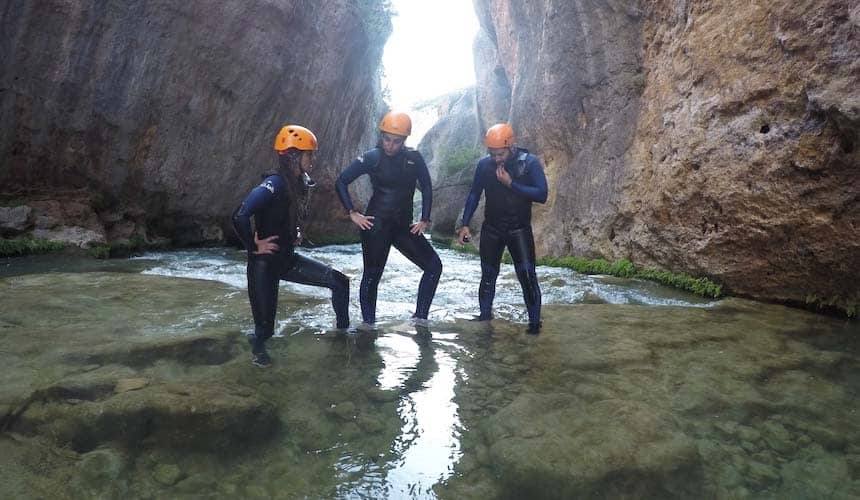
2. Swimming
Do not swim fast, except in special situations that require it. Keep calm swimming and trying to use the feet. Here it is very important, when the water currents have enough strength, to put in safety position: legs in front, semi-flexed, and using the arms as a rudder to balance and to follow the water flow. This floating technique on the water surface will make you to save energy in long canyons.
3. Diving
We must be very careful if we need to dive an underwater section of the canyon. Hydraulics, undercurrents, and sieves (or strainers) occur in flowing canyons and can trap or pin and drown a canyoneer. Wearing a diving or swimming goggles will make things easier for you. Always follow the advise of the guides or instructors.
4. Jumping
Jumping in a pothole is fun and enjoyable during a canyoning descent. But you have to be very careful when you jump. You must check that there is enough depth and the pothole is clear of rocks or trunks. If you are not sure, always us your rope and anchors to rappel or abseil. To jump safely don´t doubt, focus on the reception area, impulse yourself with one leg and quickly adopt a safe position with semiflex legs and cross your arms over your chest and keep them next to your body. If the jump is high, first extend your arms to gain balance and close them to the body just before reaching the water.
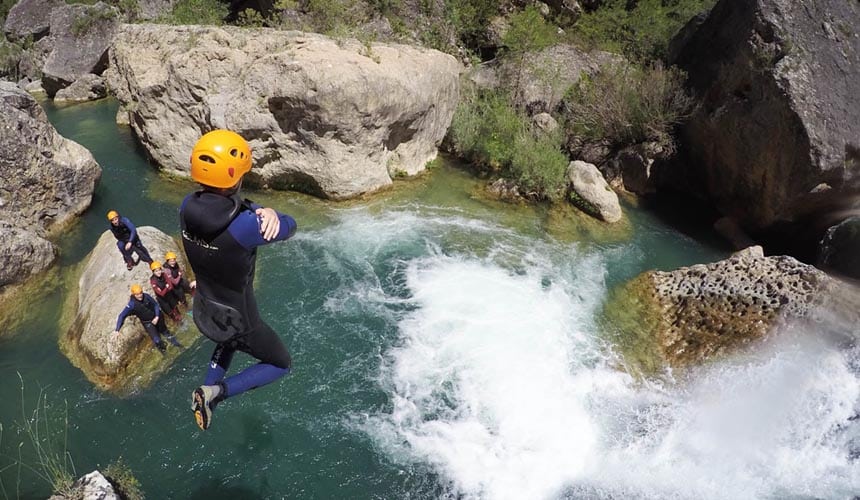
5. Sliding
Sliding through slippery rock sections into potholes is part of many canyons routes. Again always check that the reception has enough water and that there are no steps on the rock slide. Adopt safe body position with your hands and arms crossed and touching your chest, semi-flexed legs and head slightly raised up to see the way down till you reach the water. If you go on a group, always wait till the reception area is clear.
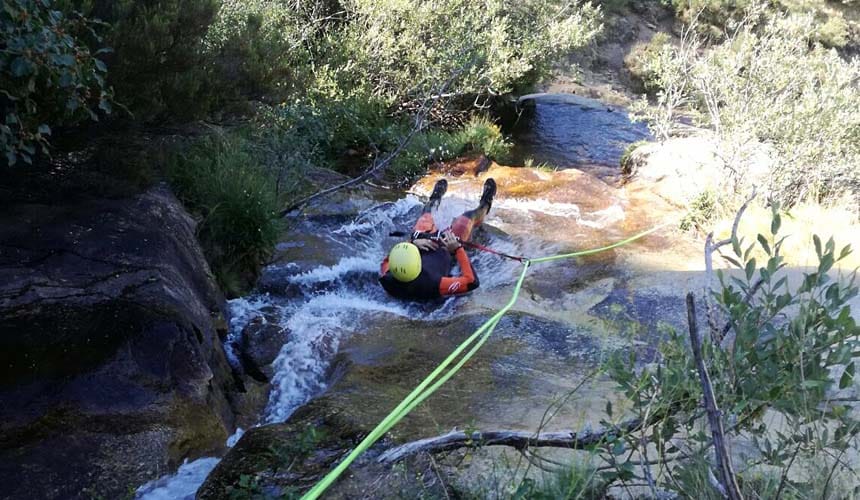
6. Scrambling down:
Intrinsically linked to the activity of canyoning, we will do some short down scramblings for easy sections with no risk of falling. You can use different techniques: opposition, face to the wall or face to the void.
7. Rappelling / Abseiling
Rappelling or abseiling is the main technique to descend vertical rock sections through the canyon safely. When jumping, scrambling and sliding is not possible or involves high risk, we will use our rope, permanent anchors and bolts fixed to the rock, the figure eight descender and screw lock carabiners attached to our harness to rappel from one terrace, cornice or ledge to the lower floor or pothole.
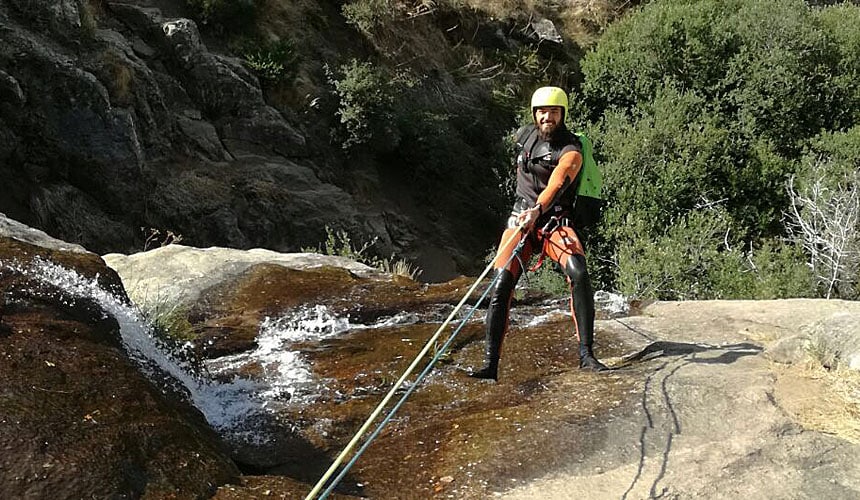
In Cuenca you can explore canyons for all levels: River Júcar Canyon, Poyatos, Majadas, Portilla and Hoz Somera canyons.
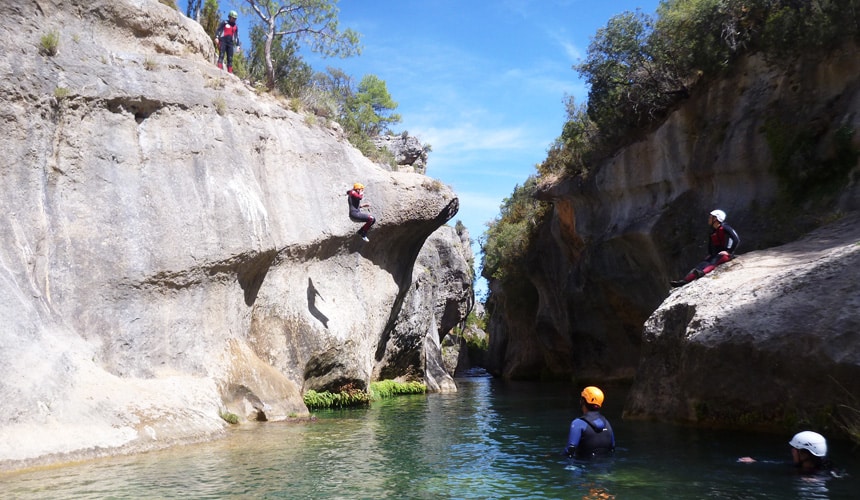
In Avila and Extremadura, less than 2 hours by car from Madrid you can practice canyoning in Papuos, Arbillas, Cascadas de Gavilanes, Garganta la Hoz y El Chorro de la Ventera canyons. It´s a perfect outdoor plan for a weekend.
CANYONING IN SPAIN
Apart from Madrid and Cuenca, popular best areas for canyoning in Spain are in Sierra de Guara, a mecca for worldwide canyoneers, Pyrennes, Costa Blanca, Granada, Mallorca and Canary Islands.
DREAMPEAKS: CANYONING IN MADRID. HIKING & ADVENTURE TOURS IN MADRID. OUTDOOR ACTIVITIES IN SPAIN.
Text by Gabriel Blanco
Mountain Guide